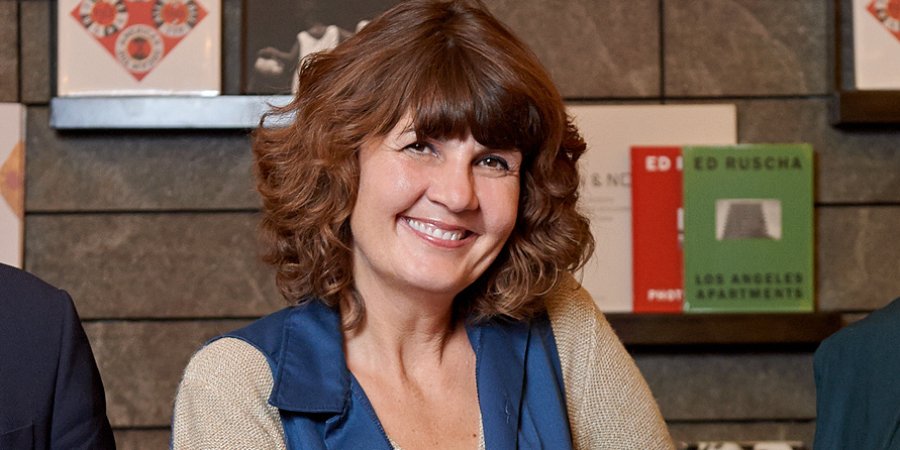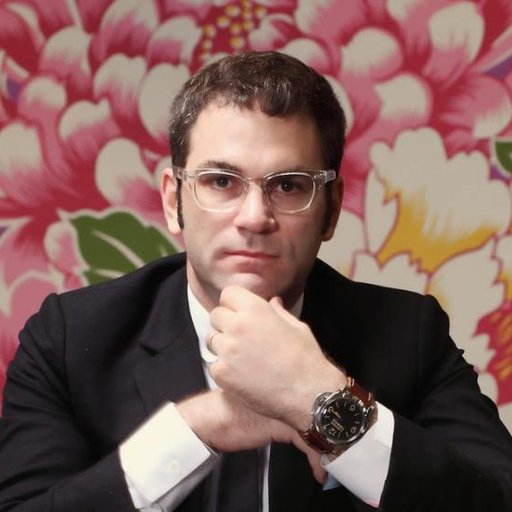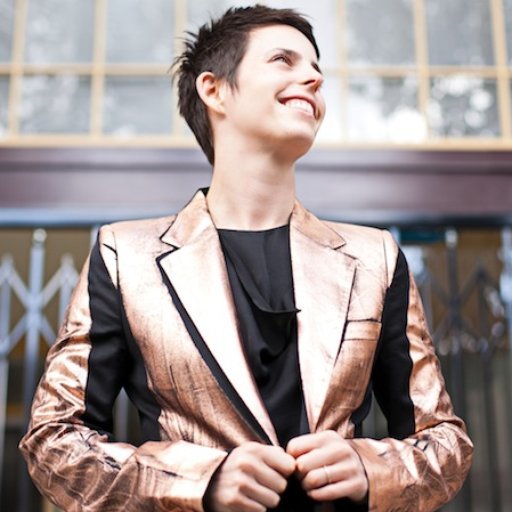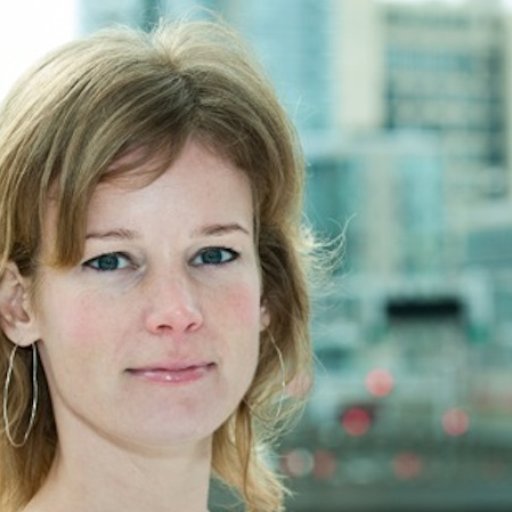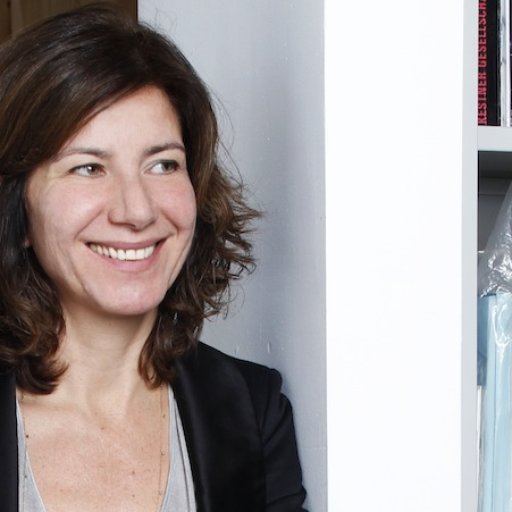Though Michelle Grabner identifies first and foremost as a painter, today she occupyies one of the most prominent curatorial perches in the world as a co-curator of the 2014 Whitney Biennial. As such, she is the first practicing artist to curate the event in its over eight-decade-long history. That said, Grabner has organized shows before, just not on this vast a scale. She operates the artist-run space called the Suburban from her 8-foot-by-8-foot backyard garden shed in suburban Chicago, and the Poor Farm with her husband, Brad Killam, near her family’s vacation home in rural Wisconsin.
Her artistic practice and pedagogical bent—she is an esteemed professor of painting at the School of the Art Institute of Chicago, a position from which she weilds considerable influence in the city's art scene—has shaped her presentation on the fourth floor of the Whitney, which she has organized as a sort of visual curriculum on various artistic processes and approaches to materials. The works on display are not just art objects but drafts and records of daily labor, from Peter Schuyff’s dozens of carefully carved wooden pencils to the late author David Foster Wallace’s notes for The Pale King (written in pink Cuddly Cuties kitten journals) to the beautiful, abstract gestures recorded across Louise Fishman’s canvases.
We conducted an interview with Grabner via email about the trajectory of contemporary painting, the redemptive art scene outside of New York, and her feminist, artist-first approach to curating the Biennial.
READ Q&A WITH THE OTHER CURATORS
Anthony Elms On The Rise Of Literary Art And The Usefulness Of Ghosts
Stuart Comer On His Shapeshifting Presentation
Of the trio of curators overseeing this Biennial, what particular focus would you say you brought to the show?
I have been articulating my focus as “curriculum building” with a concentration on “criticality, painting, and materiality.”
What was the process like working with the other curators? How did you divide the exhibition?
We each worked independently. Of course together we negotiated the aesthetics of the exhibition’s didactic material. But otherwise we simply supported each other along the way.
How did you go about choosing the artists you selected? Was there any particular area of contemporary art you wanted to represent?
I didn't go about illustrating any preconceived curatorial ideas. My areas of focus came into view once I was well into the studio-visiting phase of my process. However, there were a few artists who have been so fundamentally important to me as an artist over the years that I knew I wanted to highlight their work. Some of these artists I have worked with before such as David Robbins, Jeff Gibson, and Dan Walsh, but others I never met before including Sheila Hicks, Sarah Charlesworth, David Diao, and Ken Lum.
You are a highly accomplished artist yourself, a painter. How did that inform you choices in curating the show?
With the exception of Sheila Hicks’ material sensibility and Dan Walsh’s grid-based paintings, you cannot discern any semblance of my personal visual vocabulary in the exhibition’s artwork. Yet every artist that I included compels me critically and intellectually.
How would you describe the different varieties of paintings represented in the Biennial?
There is a full spectrum of painting included throughout the 2014 Whitney Biennial. Although I included no representational painting on my floor—choosing instead to champion contemporary abstraction—both Stuart and Anthony include representational painters.
Are there any directions in contemporary painting that you find to be particularly promising or intriguing?
I am enthusiastic to report that women are shaping painting’s discourse today.
Typically when artists are tapped to curate shows, such as Robert Gober with his presentation of Forrest Bess in the last Whitney Biennial, they are given only a moderate amount of space for exhibitions that are viewed as creative curiosities. You have been given one of the most prominent curatorial roles in the world with this show. How does your practice as a painter complement or compete with your work as a curator?
I am exceedingly comfortable in studios and among the materials of art and art-making. So needless to say, I felt confident visiting artists in their studios and sure-footed during the installing and juxtaposition of artworks in the galleries. I was least comfortable when the process of curating was merely the developing of quantifiable information. But the Whitney’s in-house Biennial team was masterful in assisting me through this process. It is not hyperbole to say that Elisabeth Sherman, Mamie Tinkler, and Martha Joseph are as responsible for the 2014 biennial as we three curators.
Where did you look for inspiration when you set out to curate the show? Were there any curators or historic shows that were particularly important to you in putting together this presentation?
When I learned that I was going to curate a section of the 2014 Biennial I bought every “used” Whitney Biennial catalog on Amazon. There are Biennials that I continue to champion as powerful curatorial ideas, such as the 1993 Whitney Biennial. And then there are moments in past Biennials that I remember with great fervor, but I can’t tell you the year or the curatorial team responsible for these moments. I am hoping that I organized and installed an exhibition in which viewers can see my curatorial “whole” while at the same time being able to engage individually with the work.
You have said that you were trying to bring an “anti-curator slant” to your selection at the Whitney. What did you mean by that, and how is that manifested in the show?
I have organized many exhibitions with this attitude, eschewing the authority of selection and deferring fully to artists. However, I knew that with the Whitney Biennial I would have to do exactly that: curate and buck it up and take control.
You also said you were interested in breaking down the “you’re in” or “you’re out” model typical of biennials. Exhibitions are, by nature, as exclusionary as they are inclusive. How did you work to broaden the scope of this biennial?
I did set out to do this—however, it proved nearly impossible. This failed claim illustrates both my idealism and my naïveté at the beginning of the curatorial process. There was this bright moment when I was working through the logistics of including a work from every artist I visited. Needless to say, there were not enough resources in the museum to make that happen. What I did do is pull back the curtain on the whole curatorial process. Mark Owens, the 2014 Whitney Biennial catalog designer, made a series of info graphics that accompany my essay detailing the statistical fallout of my undertaking.
You identify as a feminist artist. How has this guided your selections for the biennial? Is there a particular strand of feminism that you see emerging in work of the artists you’ve selected?
There is an extraordinary amount of work that is forceful, ambitious, and immense: Shana Lutker, Suzanne McClelland, Jennifer Bornstein, Jacqueline Humphries, Molly Zuckerman-Hartung, Emily Sundblad, Dona Nelson, and Louise Fishman. And then there are those who are funny, witty, and troublesome: Rochelle Feinstein, Sara Greenberger Rafferty, Pam Lins, and Amy Sillman. No strands, just influence.
In addition to being an artist and curator, you are also a very influential teacher at the School of the Art Institute of Chicago, where you play a formative role in helping many of the city’s young artists find their paths. How did your pedagogical background play into your choices as a curator here?
I am not afraid of generalities. Foregrounding similarities and highlighting sweeping statements helps balance difference and subjectivities. It is ground zero for critical thinking.
Many of the artists included in the show also come from academic backgrounds—is that due to your influence? If so, what makes them so interesting at this point in time?
Feeling uncomfortable with the idea of identifying “new talent,” I thought instead that I would put forward those artists who are influencing emerging artists: teachers and advisors.
You operate two artist-run spaces, Suburban in Chicago and the Poor Farm in Wisconsin, where you are able to work outside of institutional restraints or bureaucratic protocols. Why do you feel it is so important to leave the traditional institutional context?
After working within the hierarchy of the official institution, I am more resolved than ever to leave institutions to the professionals. They are slow and unmooring, great for art but not for artists.
What has it been like working with an institution as prominent and influential as the Whitney? What were the challenges?
Although I was asked hard questions about my curatorial choices, the museum gave me unfettered freedom to organize the show that I wanted. Of course, institutional resources are not unlimited. But isn't that always the challenge?
It’s notable that the Whitney Biennial takes place in New York, which for much of the postwar era was the center of the contemporary art discourse. In recent years that has changed, with new nodes of art-making emerging around the country and the world, and now biennials proliferate around the globe. In Arkansas, Alice Walton is planning to create a middle-American version of the Whitney Biennial. How important does the New York art scene remain to the larger art world as a generative force?
I apologize for this terrible analogy, but I have been reading about Archaic Greek pottery, so have been thinking about shipping ports and trade. Anyway, New York is not unlike a port city in Ancient times. It is the center of distribution, display, and consumption. However New York’s current relationship to exuberant amounts of money has dulled and lulled a good deal of what is presented in the commercial branches of the art world. But the good news is that we all know this and that the bright ones are working within this condition to gain interesting cultural momentum. Best of all, New York has the peerless Met, especially if one is so moved by Archaic artifacts.
How do you view the Whitney Biennial as an institution, and how relevant does it continue to be in terms of providing a snapshot of new currents in contemporary art?
Let’s just say that I hold on to the hope that someday I too will be included in the Whitney Biennial.
READ THE REST OF OUR WHITNEY BIENNIAL COVERAGE
Amy Sillman on Painting, Stand-Up Comedy, and Making Inappropriate Art
5 Ways of Looking at the 2014 Whitney Biennial
A Brief History of the Whitney Biennial, America's Most Controversial Art Show











